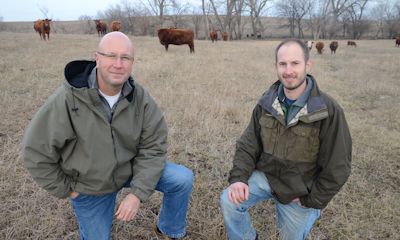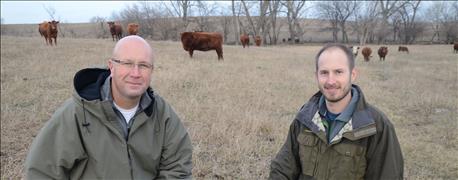
Last summer, when Del Ficke was rotating cattle through his pastures, he got used to hearing drivers hitting the rumble strips on Highway 6 near a 12-way cover crop mix he seeded for grazing. "I could hear people hit the rumble strips from cars moving over to the shoulder to see what I was doing," Ficke says. "I knew right then I had an audience."

MADE FOR GRAZING: Del Ficke and Nate Belcher with some of Ficke's Graze Master Genetics composite cows. These composites are made up of Red Angus, Simmental, Hereford, and Aubrac. The result is forage efficient cows that are high in butterfat, which equates to meat tenderness. They also have longevity, Ficke says, which results in less costs.
You might not know it now, but Ficke wasn't always growing cover crops for grazing. Over the last fifteen years, he has planted cereal rye, and over that time, has added different species. In the last three years, he's branched out into cocktail mixes to take soil health up a notch and cut back on his dependence for commercial inputs, while extending the grazing season for cattle.
It's just one of the components that help complete the circle at Ficke Cattle Company west of Lincoln, where Ficke has been looking at new ways to net more per acre since the family operation was passed down to him in the 1980s. "When we started out, we changed this operation daily. Now, we change it twenty times a day," he says. "It's all a work in progress."
A work in progress
It started with rotational grazing – taking a bite and moving on, while giving the pasture enough rest before coming back for seconds. Moving every day helps prevent selective grazing, allowing multiple species to thrive. By subdividing pastures into multiple paddocks, giving ample rest period, and ensuring enough residual is left over, it helps make more efficient use of pasture acres and even extend the grazing season.

DIGGING IN THE DIRT: Nate Belcher (left) and Del Ficke inspect the structure of the soil from a field planted to a cover crop mix on Ficke's farm west of Lincoln. Ficke is partnering with Belcherto turn his farm into a research site. Here, Ficke is growing cover crops for grazing and seed, and using the site to demonstrate the potential of different species and mixes for grazing.
Ficke's pastures consist of cool seasons like brome as well as native prairie. However, he's using rotational grazing to improve pasture diversity by mixing in red clover and sweet clover seed with mineral and letting the cattle distribute it through manure, or broadcasting it in the pasture before grazing cows to get seed to soil contact through animal traffic.
~~~PAGE_BREAK_HERE~~~
But Ficke also takes advantage of less desirable species when grazing – like reed canary grass, ironweed, and even marestail. This works best when these plants are young, and are grazed for a day before cattle are rotated, preventing selective grazing. "I don't have weeds, I have opportunities," Ficke says. "Everything can be grazed if you do it at the right time – God put it there for a reason."
Through rotational grazing and cover crop grazing, he's cut back on hay costs. But when he does need to feed hay, he uses spaced bale feeding, allocating one or two bales, and fencing other bales off. This way, cattle spread hay out, spreading out nutrients, and traffic is concentrated in a specific area. "Feeding hay doesn't cost me much money because I put $40 back into the soil in nutrients and seed," Ficke says. "We feed cows hay on our poorest soil. I'm seeding, fertilizing, and feeding in a half hour."
Cover crops have helped complete the circle. This includes sorghum sudan for grazing, hairy vetch for nitrogen fixation, grazing corn, grazing soybeans, sweet clover, radishes, and cowpeas, in addition to pearl millet and Japanese millet for hay and grazing.
By integrating cover crops and cattle, Ficke has cut his commercial fertilizer bill in half on his row crop acres, and his goal is to cut out commercial fertilizer entirely. "You're adding more nutrients through manure and urine and there's a huge advantage to that," he says. "We don't spread as much manure anymore. Now it takes less time, and we let cows distribute it while they graze."
Completing the circle
Now, Ficke is partnering with Nate Belcher, owner and operator of Green Acres Cover Crops, to turn his farm into a research site. Here, Ficke is growing cover crops for grazing and seed, and using the site to demonstrate the potential of different species and mixes for grazing.
And Belcher notes soil health, cover crops and cattle complement each other well. "By grazing cover crops with the right pattern, you're building soil faster than you could any other way," he says. "As cattle graze, the plant's response is to exude more carbon to increase the biology around the plant, and grow as much as it can. You're exuding carbon into the soil through the act of grazing itself, and through the animal as manure, and of course you get regrowth above ground."
~~~PAGE_BREAK_HERE~~~
Belcher has urban farmed in Oklahoma and Nebraska, including at his home in Omaha, and his only input has been cover crops. Although it can take some adjustments in management and equipment to establish cover crops at the right time, it's scalable and can help reduce inputs on larger farms, he notes.
"We're growing water holding capacity, cycling carbon, fixing and sequestering nitrogen, fighting weed pressure, all just by planting seeds, which every farmer knows how to do. It's not a totally new concept to learn," Belcher says. "That's when it becomes applicable on a much grander scale."
"People have trouble thinking outside the box, and if they don't have grass, they don't think they can raise cow-calf pairs," Ficke says. "There are a lot of people asking questions about cover crops. With lower grain prices and pasture becoming scarce, this is a good time to look into cover crops to reduce input costs."
Read more about Ficke and Belcher in the February Nebraska Farmer.
About the Author(s)
You May Also Like






